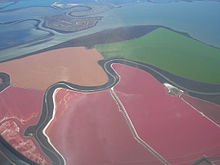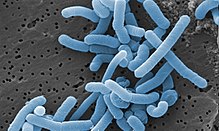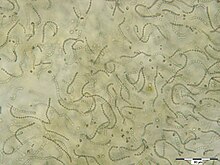Germ of the year
The Microbe of the Year was first named in 2014 by the Association for General and Applied Microbiology (VAAM). The aim of this annual special highlighting of a microorganism is to draw attention to the value of bacteria , archaea or fungi for the individual and for society. The microbe of the year is selected by a jury of microbiologists , taking into account in particular the importance of the respective microorganism in the field of ecology , medicine , technology , food management , energy generation , history or research .
In some years , the public presentation of the microbe of the year is accompanied by a school and student competition under the motto “Find the microbe of the year”. Participants can submit photos, videos or other creative and artistic designs relating to the microorganism presented and win internship positions in school laboratories and institutes as main prizes.
The microbe of the year is announced shortly before the turn of the year for the following year.
Previous microbes of the year
| year | Surname | description | image | |
|---|---|---|---|---|
| 2014 | Nostoc | The Nostoc species belong to the cyanobacteria ("blue-green algae") and live in a gelatinous shell on meadows and in lakes. They are an indicator of a healthy ecosystem and offer approaches for medicines and biofuels. |
||
| 2015 | Rhizobium | The species of the genus Rhizobium belong to the so-called nodule bacteria and facilitate the cultivation of legumes (legumes); these include economically important crops such as beans , peas , lentils , peanuts and clover .
Among the species of the genus include, but are Rhizobium radiobacter (also known as Agrobacterium tumefaciens ), and Rhizobium rhizogenes (= Agrobacterium rhizogenes ) that are closely related to the Bradyrhizobium - species. |
||
| 2016 | Streptomyces |
Streptomycetes play an important role in the ecology of the soil. They secrete numerous enzymes and thus break down many complex substances, for example substances that are difficult to break down such as cellulose from wood or chitin from insect shells and fungi . The resulting smaller nutrients serve as food for the streptomycetes. These bacteria ensure the recycling of plant fibers and residues of dead organisms and thus contribute significantly to the formation of compost and humus. The typical scent of fresh forest soil also comes from bacteria of the genus. Streptomycetes produce many medically used active ingredients that kill bacteria, fungi or parasites and inhibit the growth of tumors.
Streptomyces has already been honored with the Nobel Prize twice : as a producer of the antibiotic streptomycin (1952) and of the anti-worm infection ivermectin (2015). |
||
| 2017 | Halobacterium salinarum |
Halobacteria belong to the group of halophilic archaea , which are similar to bacteria but are more closely related to plants and animals . Like other arks, Halobacterium salinarum is adapted to extreme biotopes (→ “ Extremophile ”), namely to extremely high salt concentrations; the archaeon occurs in salt pans and brines and can survive in salt crystals for hundreds of years. In the event of mass reproduction, its red coloring agents ( carotenoids ) can color the habitat reddish-purple and accumulate in the food chain, so that they enter the body of flamingos via brine shrimp and determine the pink color of their plumage.
Halobacterium salinarum can - like Halobacterium halobium - convert light energy into energy for the metabolism with the help of bacteriorhodopsin , the biochemist Dieter Oesterhelt discovered in 1971. It is remarkable that a similarly structured rhodopsin in the mammalian eye is responsible for the visual process: The evolution of the biochemical basis of visual perception is apparently rooted in archaic microbes . Osterhelt's research ultimately also opened the way to optogenetics . |

San Francisco Bay Salt Ponds: Halophilic arcs color water surfaces for salt extraction.
|
|
| 2018 | Lactobacillus | Lactobacteria, along with other types of bacteria, belong to the group of lactic acid bacteria that produce lactic acid through fermentation . In many cultures, food is produced and consumed almost every day by almost everyone that was produced with the help of lactobacteria. a. Cheese and yogurt , salami and sauerkraut , canned beetroot and olives , gherkins and bread from sourdough . “ Lactobacillus forms lactic acid from the carbohydrates present . As a result, the pH value drops so much that harmful bacteria cannot multiply: Food becomes durable. About 5000 such lactobacillus fermented foods are known worldwide. " |

Lactobacillus paracasei is a rod-shaped bacterial species that is one of the most common species of the genus in the milk processing industry.
|
|
| 2019 | Magnetospirillum | "Magnetic bacteria" were first described in 1963 by the Italian Salvatore Bellini. Inside they have chains of 15 to 30 magnetite or greigite crystals, which together act as magnets and align themselves horizontally in the magnetic field like a compass needle . This makes it easier for you to distinguish between “above” and “below” perpendicular to this alignment: Under water, you specifically look for layers in the ground with the optimal low oxygen content for you. “In laboratory tests, isolated magnetosomes clearly outperform commercial magnetic contrast media ; this makes them interesting for magnetic resonance imaging (MRT) or imaging methods in research and medical diagnostics . " |

Magnetospirillum gryphiswaldense with magnetosomes . The species lives in deeper, oxygen-poor sediment layers. Due to the alignment with the earth's magnetic field, they can follow the oxygen gradient running from top to bottom particularly easily, perpendicular to it.
|
|
| 2020 | Myxococcus xanthus | “ Myxococcus xanthus is an active hunter in the group who uses other bacteria as a source of food. To do this, the tiny rod-shaped bacteria have to communicate with one another and coordinate their behavior. ”However, the bacterial cells not only release complex messenger substances that serve to communicate with one another, but also toxins and enzymes that help kill and break down other cells. Researchers therefore suspect that the active ingredients released by myxobacteria could be used as a source for the development of novel antibiotics.
The name of the bacterium is derived from its appearance: its fruiting bodies are yellow (Greek xanthos ), its spores are spherical ( coccos ), and the cells produce a mucus ( myxa ) that holds the community together. |

"Fruit body" of Myxococcus xanthus (enlarged approx. 50 times).
When there is a lack of food, countless cells accumulate in a targeted manner in spherical piles that resemble the fruiting bodies of a fungus. |
See also
Web links
- Official website of the Microbe of the Year
- Website of the organizer
- NABU: Overview "Nature of the Year". On: nabu.de , accessed on December 28, 2017
Individual evidence
- ↑ Felicitas Pfeifer: Microbe of the year 2014 - the cyanobacterium Nostoc. In: Biology in Our Time. Volume 44, No. 5, 2014, p. 283, doi: 10.1002 / biuz.201490068 , full text (PDF)
- ↑ Very small, but very significant. Rhizobium is Microbe of the Year 2015. On: scinexx.de from February 10, 2015
- ↑ Microbe of the year: Rhizobium calls for competition. On: agrarzeitung.de from February 10, 2015
- ↑ Student finds the microbe of 2014! Winner of the competition awarded with internship. On: idw-online.de from October 2, 2014
- ↑ Pfullendorfer Brothers find Microbe of the Year. On: suedkurier.de from October 7, 2014
- ↑ "Microbe of the Year" selected. Nostoc is a true survivor. On: rhein-neckar-zeitung.de from April 18, 2014
- ↑ Harald Engelhardt: Microbe of the year 2014: Nostoc - all-rounder with an eventful past. In: BIOspectrum. Volume 20, No. 2, 2014, pp. 234-235, doi: 10.1007 / s12268-014-0431-4
- ↑ Iris Maldener: Nostoc, a prokaryotic multicellular cell. Microbe of the year 2014. In: Biology in Our Time. Volume 44, No. 5, 2014, pp. 304-310, doi: 10.1002 / biuz.201410545
- ↑ Timo HJ Niedermeyer: Biologically active natural substances from cyanobacteria of the genus Nostoc. In: BIOspectrum. Volume 20, No. 2, 2014, pp. 151-153, doi: 10.1007 / s12268-014-0420-7
- ↑ Susanne Zehner and Michael Göttfert: Nodule bacteria: helpers of agriculture. Microbe of the year 2015. In: Biology in Our Time. Volume 45, No. 5, 2015, pp. 296-302, doi: 10.1002 / biuz.201510573
- ↑ Toxic symbiosis. Kiel study shows: Microbe of the year responsible for plant toxins. On: idw-online from March 17, 2015
- ↑ Harald Engelhardt: Symbiotic bacteria make plants frugal and people satisfied. In: BIOspectrum. Volume 21, No. 2, 2015, pp. 232-233, doi: 10.1007 / s12268-015-0564-0
- ↑ Anke Becker: Knöllchensymbiosis - when plants and bacteria understand each other. In: BIOspectrum. Volume 21, No. 2, 2015, pp. 151-153, doi: 10.1007 / s12268-015-0551-5
- ↑ Simon Irmer et al .: New aspect of plant-rhizobia interaction: Alkaloid biosynthesis in Crotalaria depends on nodulation. In: PNAS . Volume 112, No. 13, 2015, pp. 4164-4169, doi: 10.1073 / pnas.1423457112
- ↑ Hildgund Schrempf and Ullrich Keller: Streptomycetes: relevance for ecology, medicine and biotechnology. In: BIOspectrum. Volume 22, No. 1, 2016, pp. 22-25, full text (PDF)
- ↑ Streptomyces: Microbe of the year saves many lives. In: ÄrzteZeitung from February 16, 2016, full text
- ↑ Microbe of the Year 2016: Streptomyces - Nobel Prize Winner and Recycling Professional. On: idw-online.de from February 11, 2016
- ↑ Harald Engehardt: Streptomyces, Microbe of the Year 2016: Streptomyceten - the pharmacists among microbes. In: BIOspectrum. Volume 22, No. 1, 2016, pp. 104–106, full text (PDF)
- ↑ Microbe of the year 2017: Halobacterium salinarum - the single-cell archetype of sight. On: vaam.de , accessed on January 23, 2017
- ↑ Felicitas Pfeifer: Red survivors in salt lagoons. In: BIOspectrum. No. 1, 2017, full text (PDF)
- ↑ Christina Beck: Protozoa shed light on neurobiology. In: MaxPlanckResearch. No. 3, 2014, pp. 18-25, full text (PDF)
- ↑ Harald Engelhardt: Did microbes bring us sight? In: BIOspectrum. No. 1, 2017, full text (PDF)
- ↑ Peter Hegemann and Andreas Possible: What is optogenetics? In: Humboldt spectrum. No. 1, 2012, pp. 10–17, full text (PDF)
- ↑ Stefan Streif: Understanding Phototaxis of Halobacterium salinarum. Dissertation, Otto-von-Guericke University and Institute for Automation Technology , Magdeburg 2011, doi: 10.2370 / 9783844000917
- ↑ Microbe of the year 2018: Lactobacillus - delicious and healthy. On: vaam.de , accessed on December 28, 2017
- ↑ Charles MA Franz et al .: Lactobacillus - Microbe of the year 2018. Our daily bread: Helpers in food fermentation. In: BIOspectrum. No. 1, 2018. Online advance publication in December 2017, full text (PDF)
-
↑ Microbe of the year 2019: Magnetospirillum: Bacterial orientation - attractive for futurology. On: vaam.de from December 28, 2018
See also:
Magnetospirillum researchers from the very beginning : Questions to Prof. Dr. Dirk Schüler, University of Bayreuth. On: vaam.de from December 28, 2018
Magnetospirillum: Pointing the way. On: vaam.de from December 28, 2018 - ↑ Microbe of the year 2020: Myxococcus xanthus - social and communicative. On: vaam.de from December 28, 2019.
- ↑ Cystobactamide: Antibiotics of the Future? In: In fact. The magazine of the Helmholtz Center for Infection Research. No. 1, May 2019, p. 13. Also on: helmholtz-hzi.de , May 2019, last viewed on December 30, 2019.


